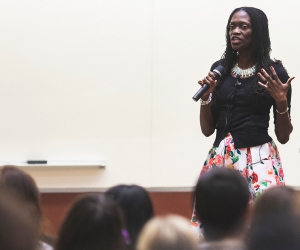
Professor Provides National Guidance on Braille Code Changes
The braille community in the United States is adjusting to major changes to the braille code — the most significant changes in more than 30 years, in fact.
Up until 2016, braille materials were provided in two formats. Literary code was delivered through the English Braille American Edition (EBAE) and mathematics and science code was delivered through Nemeth code. A third code, Computer Braille Code, was also used in some specialized situations.
Then EBAE code was phased out. It was replaced by the Unified English Braille Code (UEB), which combines literary code and mathematics, science, and computer code into a single format. In other English-speaking countries, the decision was made to produce all braille materials only in UEB code, but in the United States there continues to be two options to produce math for braille readers — UEB code and Nemeth code.
Confused? So are some educators, state administrators, and policy makers. As are textbook manufacturers and college entrance test makers.
Frances Mary “FM” D’Andrea, a faculty member in the vision studies program at the University of Pittsburgh School of Education, has worked diligently to ensure a smooth transition with the braille standards. She recently made a major contribution as the author of the policy brief “Considerations for States Providing Materials in Braille,” published by the National Center for Educational Outcomes (NCEO) in October 2019.
“This change from the old code, English Braille American Edition (EBAE), to Unified English Braille (UEB) was major and reflects a quarter century of work by an international group of experts — mostly braille readers — to create this unified code,” said D’Andrea.
Ensuring a Smooth Transition
D’Andrea is the chair of the UEB committee for the Braille Authority of North America (BANA) and has been a board member for more than 20 years. She says BANA decided to keep both UEB and Nemeth as official codes in the United States for the convenience of braille readers using Nemeth. Furthermore, there is also the bureaucratic complexity of a rollout involving 50 states that are each different in how they procure and produce braille materials.
“BANA felt that maintaining a well-established math code would be less disruptive than changing both literacy and technical materials so drastically,” she said. “While it has caused some confusion, thus my NCEO brief, initially there were fewer resources for math in UEB at the time of adoption. Now there are more resources and people are feeling more comfortable.” BANA’s position is that both codes should be available for math and science transcriptions, based on the needs of individual readers.
To ensure that future educators stay cutting-edge, the new braille code standards are being taught in the Vision Studies programs at the Pitt School of Education. The school offers certifications in Teacher of Students with Visual Impairments and Orientation and Mobility Specialist. Graduates of the programs have a 100 percent placement rate and are employed all over the country.
History of Braille
Invented in the mid-1820s by Louis Braille of France, braille is a tactile system of reading and reading that follows whatever content is presented in the original text. Compared to print, it is a very young writing system.
Globally, there are 142 countries and 133 languages for which a braille code has been created, according to the book World Braille Usage. Some countries have their own braille authority; others do not. There is no worldwide braille authority, although there is an advisory body called the World Braille Council through the World Blind Union.
“Over time, there has been recognition that consistency and standards are good for our students. If braille is done sloppily or incorrectly, it’s unreadable. It’s expensive enough to produce braille textbooks and national assessments, so it only makes sense to make sure it’s done consistently and accurately,” said D’Andrea.
With the policy brief she published through NCEO, D’Andrea is aiming to reach state level assessment administrators, school superintendents, special educator directors, and any other person involved in ensuring that materials are available in braille.
“The brief is designed to sort out some of the confusion for people who are involved with braille procurement but may not know the codes,” she said.
Learn More
Explore the Vision Studies program at Pitt Education




